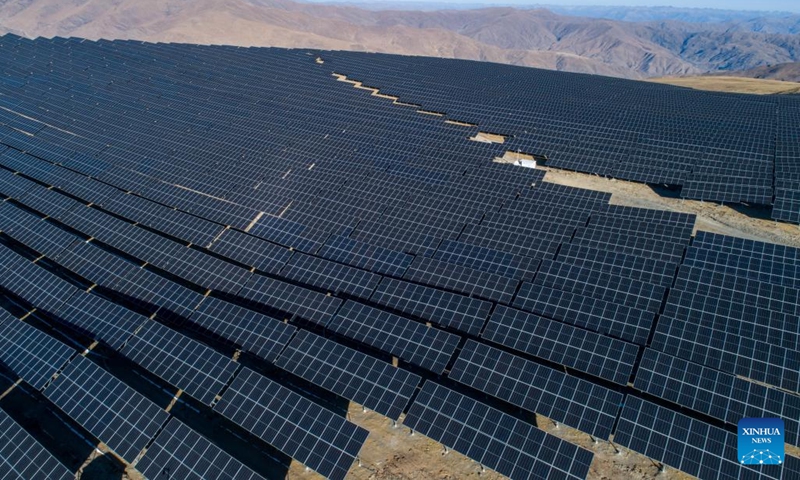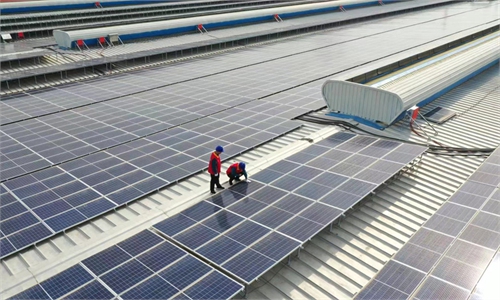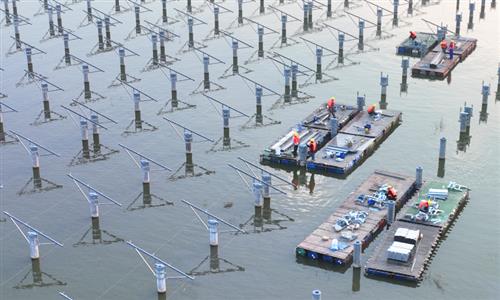China opens ‘golden circuit’ in new-type energy storage, promoting 100b yuan of investment

An aerial drone photo taken on Jan. 15, 2024 shows part of Cerbong photovoltaic power station in Shannan City, southwest China's Xizang Autonomous Region. Located in Nedong district of Shannan City on the Qinghai-Tibet Plateau, Cerbong photovoltaic power station is currently the highest-altitude of its kind in the world. The project started to upload electricity to the power grid on Dec. 30, 2023.(Photo: Xinhua)
China has opened a "golden circuit" in developing its new-type energy storage, as a number of provinces are stepping up efforts to apply new-type energy storage technologies, in a bid to advance the green energy transition.New-type energy storage refers to energy storage technologies, other than pumped storage, in which the main form of energy storage is the output of electricity. In 2024, "development of new-type energy storage" was written into the Government Work Report for the first time.
Experts said on Wednesday that new-type energy storage is becoming a key technology in China's efforts to build new energy and power systems, as well as an important means of promoting the green and low-carbon transformation of energy production and consumption.
In Rudong, East China's Jiangsu Province, the country's first 100-megawatt-hour gravity energy storage project is under construction. Within a month or so, the project will be formally put into operation.
Gravity energy storage is a mechanical energy storage method. Its main principle is to use the surplus power generated by new energy to lift the gravity block for "charging." At times of peak electricity consumption, it will put down the gravity block to "discharge," so as to provide electricity for the power grid.
Baotang Energy Storage Station in Foshan, South China's Guangdong Province, is the largest independent lithium battery energy storage station built in China. It can deliver 430 million kilowatt hours (kWh) of clean electricity to the region every year, and reduce carbon dioxide emissions by 300,000 tons.
Facing challenges and opportunities of the new power system, China is exploring more means of energy storage. China's first salt cavern compressed air energy storage facility started operations in Jiangsu Province in 2022.
The power station uses electric energy to compress air into an underground salt cavern, then releases air to drive an air turbine, which can generate electricity when needed. The energy storage capacity in each cycle reaches 300,000 kWh, equal to the daily consumption of about 60,000 residents.
Gravity energy storage and compressed air energy storage are typical types of diversified energy storage technologies, known as physical energy technologies, Liu Yong, secretary-general of the Energy Storage Application Branch of China Industrial Association of Power Sources, told the Global Times on Wednesday, adding that chemical energy storage technologies account for more than 90 percent of the international market.
Liu said that progress in compressed air energy storage is expected to have further positive results during the 14th Five-Year Plan (2021-25) and 15th Five-Year Plan (2026-30).
Since the beginning of the 14th Five-Year Plan period, newly installed new-type energy storage capacity in China has directly promoted investment of more than 100 billion yuan ($13.93 billion), driving further expansion of upstream and downstream industrial chains.
As of end-2023, installed new-type energy storage capacity in China stood at 31.39 gigawatts, with a 2.1-hour average energy storage time. During 2023, 22.6 gigawatts of new-type energy storage capacity were installed, up 260 percent year-on-year and nearly 10 times the figure as of end-2020.
At the beginning of this year, the National Energy Administration released a list of 56 new-type energy storage pilot demonstration projects, including 17 lithium-ion battery projects and 11 compressed air energy storage projects. Some of these projects have been connected to the grid, effectively promoting the application of new technologies.
So far this year, the number of registered energy storage projects in Guangdong has increased by more than five times year-on-year, and Jiangsu will have 4 million kilowatts of new-type energy storage integrated into the State Grid this year.



